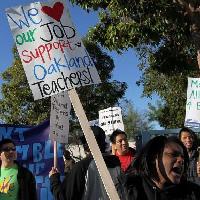
Women will be propelled to the forefront of struggles
To bridge significant budget shortfalls created by the Great Recession, state and local governments cut spending and increased taxes in each of the last several fiscal years.
Since 2008, 46 states have cut essential services in health, education, human services or public safety, including layoffs. Women will experience the adverse effects of state and city budget cuts both as workers and as recipients of essential services.
Education
Thirty-four states and the District of Columbia have cut funding for education since the beginning of the recession, some quite dramatically. New York’s 2011 budget will cut $1.1 billion from K-12 education, California’s $1.5 billion from K-12 and community college education.
The days of finding small efficiencies in the system are long past. In New Jersey, 93% of school districts plan teacher layoffs as a result of Governor Christie’s $820 million cut to state aid for education this fiscal year.
One of the first careers open to women, teaching, especially at the K-12 level, remains overwhelmingly female. Women make up 82% of all elementary and middle school teachers, 98% of all pre-school and kindergarten teachers and 91.5% of all teachers’ aides. With official unemployment hovering between 9 and 9.5%, finding another teaching job or any job with benefits and a pension is extremely difficult.
Beyond the workplace, cuts in education affect women as mothers of school-aged children. Before- and after-school programs, essential for working women, are often among the first to be cut.
Cost shifting of basic supplies from the school to the families means parents must provide not just pencils but paper towels, tissues and sanitizing wipes for the classroom. Cutbacks in education affect women’s ability to provide for their families, keep their children safe before and after school, and balance work and family responsibilities, increasing stress and decreasing women’s quality of life.
Health
Likewise, 31 states have cut funding for health care since the beginning of the recession. These cuts have direct and devastating consequences for women as workers, as patients and as the health care providers of last resort for dependent children and elderly parents.
Though states, cities and counties closed many of their public health and mental health institutions in the 1970s and 80s, a significant portion of health care remains in the public sector through the public clinic systems, home health programs and school districts. Much of the health care provided by private, even private, for-profit agencies and facilities is paid for by tax dollars through Medicare and Medicaid. With 92% of registered nurses, 91% of licensed practical/vocational nurses and 88% of nurses’ aides and home health aides being women, layoffs in health care mean layoffs for women.
Women will also be adversely and disproportionately affected by any cuts to Medicare and Medicaid. Medicare provides health insurance for elderly Americans. Women live longer than men and, therefore, account for 57% of all Medicare recipients.
Medicaid provides health insurance for low-income Americans. Women, particularly unmarried women, are significantly less wealthy than men. Therefore, women account for three-quarters of all adult Medicaid beneficiaries. Medicaid pays for 41% of all births and 71% of all publicly funded family planning services in the U.S. One million people in Arizona will lose access to health services provided by the state as a result of the Medicaid cuts there.
Federal stimulus funding provided approximately $100 billion to offset education budget gaps since February 2009. The Center on Budget and Policy Priorities estimated that these dollars funded 266,000 jobs in education. Stimulus programs provided another $40 billion to state health budgets by increasing Medicaid reimbursements and other subsidies. With all monies from federal stimulus programs and the August 2010 jobs bill set to expire in the next six months, states, cities and school districts will be left on their own with budget shortfalls.
The mainstream women’s groups like NOW and NARAL have no answer to this crisis, beyond bemoaning the results of the November elections and exhortations to lobby the Democrats, who share equal responsibility for the cuts with the Republicans.
Almost eight million workers in the public sector are represented by a union. These workers, female and male, must campaign in their unions for a militant fight-back to protect jobs, benefits and, most importantly, the services they provide. The unions need to organize with parents, students, patients and all other constituent groups to demand that the richest 1% and big business pay for this crisis, not working and poor people.
Necessity will propel women to the forefront of these struggles where they will lead, teach and learn. The best will draw revolutionary conclusions and see the need to replace the oppression of capitalism with the genuine equality of socialism.


Be the first to comment